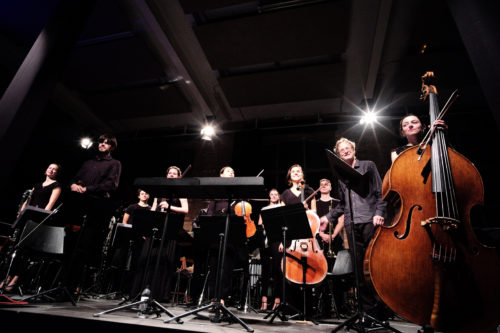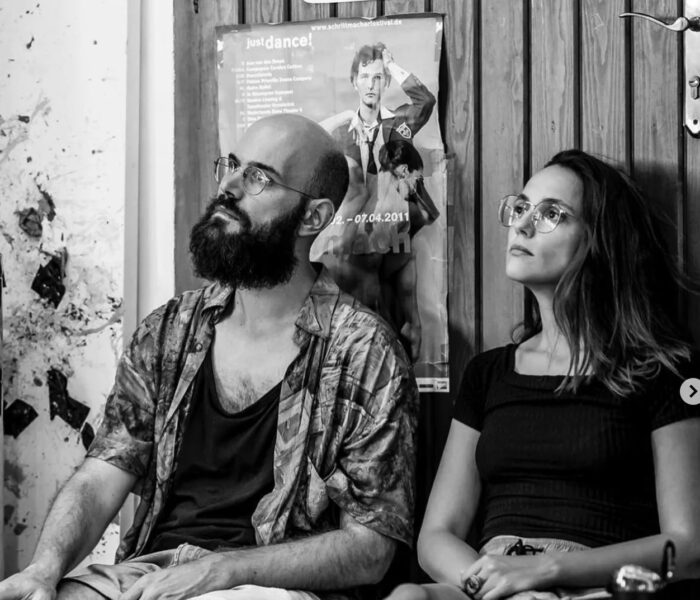José Río-Pareja (Barcelona, 1973) is one of the most solid figures on the contemporary Spanish music scene. His career is long and rich. After obtaining various advanced degrees in composition at the Conservatorio Superior Municipal de Música de Barcelona, José Río-Pareja persisted in his fertile artistic research, exploring all the limits of sound to the point of defining himself, at present, as a composer of exquisite language and unsettling sensitivity. Between 2002 and 2007, he completed his doctorate at Stanford University in the United States under the tutelage of Brian Ferneyhough, with whom he personalised his personal style. After receiving several awards, such as the SGAE First Prize in 2000 and the INAEM Prize in 2008, José Río-Pareja is now a composer of note, and continues to be - as he explains in this interview - that excited child who imagined the universe of sound by watching the sun's rays break up in the waves of the sea. He now teaches composition at the Escola Superiore de Música de Catalunya (ESMUC).
We talked to him about his career, his style and his works, including Nomada S5Nomada S5, a work commissioned by the Mixtur festival and Hémisphère son.
José Río-Pareja, what allows you to continue developing your talent?
My passion for composition. In fact, I think that, beyond aesthetic differences, if there is one thing that most of us composers dedicated to contemporary music have in common, it is the passion and love for sound creation, for our craft. And in my case, I would say that this is the basis of everything.
And your perseverance in investigating and exploring?
Yes, to move forward and experiment in each work and find interesting sonic elements to develop in the next piece, even elements that could perhaps mean a leap into the void, a chasm into the unknown. Perhaps this is what makes composition so interesting, the fact that something as alive as sound is just waiting to be discovered. Without a doubt, music-making allows for this exploration.
You will be giving a talk at the MIXTUR festival on October 1st. What do you want to share at this event?
I would like to talk about my music. I will focus on the work that the Mixtur Festival and Hémisphère son have commissioned from me, Nomada S5a creation for the ULYSSES Ensemble that is clearly linked to other works of mine. I will talk about and reflect on those musical elements and parameters that I have been developing for many years; pieces that in one way or another have been linked to analogies between sound and light effects.
Like in the play Parhelia (2018)?
Yes, among others. On the one hand, I was interested in the optical effects of the sun - like in Parhelia or another of my works entitled Ein Rausch im Sonnenglanz (2013-2014), which could be translated as "The Drunkenness of the Sun". On the other hand, those stellar light phenomena related to variations in brightness found, for example, in binary star types, such as variable stars. My works Lumisosa azul (2016) and Estrellas Variables (2015) play with these analogies. I look for these kinds of sonic analogies with the light effects found in celestial bodies.
And how are these analogies configured?
I am interested in creating minimal changes in the spectrum, in controlling sound structures that can be manipulated at a microscopic level, in working at very small levels of variation related to frequency and amplitude. Previously, my works have been born out of this desire. However, I have done so by basing myself more on the music of old and traditional songs, a cappella songs present throughout the Iberian Peninsula, such as the primitive saetas, the harvest and threshing songs or the alalás from the north of A Coruña (in Galicia). The different folk songs are very interesting because they are also deeply complex in terms of the elasticity and fluctuation of the frequencies they present, going beyond the twelve semitone system or the equal tempered system used in most musical aesthetics.
But now you are focusing more on abstract issues ?
Exactly. I have been looking for more abstract analogies, like light effects.
How do you usually approach a composition: is the process the same in all your works or do you create according to each one?
It depends a little on the commission, although my works are linked to each other. I try to follow an evolution, to explore my interests, to go step by step, to go from piece to piece developing the different constructive aspects that motivate me. For example, the work Los incensarios (2018) commissioned by the Spanish National Orchestra, I linked it to some folk music that I was already interested in. In fact, I combined these two ideas, this imaginary of analogies between sounds and light effects, incorporating material based on melodies from my childhood, such as the primitive saetas sung in southern Spain.
Your career as a composer is extensive and fruitful. In perspective and with the experience of the years, what would you say to the young composer José Río-Pareja of the early days?
That's a good question, and a very complicated one to answer. I had never thought about it. (José Río-Pareja smiles. He thinks for a few seconds before answering). I'd need more time to answer, but now that we're talking, I'll tell you that, as a child, I remember floating in the sea while playing dead and immersing my ears in that liquid acoustic environment: it was an exciting and different sensation that fascinated me. Maybe this search for certain accumulations of spectral harmonics that interest me has to do with this strange and curious sensation of being in a non-gaseous atmosphere, so different from our usual atmosphere. In salt water, your ears perceive these sound differences, you even feel the compression of the eardrums. There is also the visual. As a child, I was mesmerised by watching the different reflections of the sun on the waves of the sea, which seemed to light up in a chaotic and free way.
What did you learn from Professor Brian Ferneyhough?
Courage and creative freedom. I appreciate very much his esteem for the advancement of my aesthetic language. I knew from the beginning that he would encourage this path. His music explores extreme details, offers possibilities for the performer to go beyond a spontaneous interpretation, allows one to reflect on how far to go in reading a score. In fact, his attention to exploring the performers' space is one of the reasons I went to study with him at Stanford. I'm referring to the control of vibrato, micro-interval fluctuations, timbre and noise, all those elements that personalise the performer and that, in fact, can also be used as elements to build the discourse and deepen the expressive capacity of the sound. We composers can experiment with this additional expressiveness offered by the performer, work with this ornamentation.
Some of the titles of your works are suggestive: Red threads of desire (2003), La rivière sans socle (2009) or Tempus fluidum. They suggest emptiness, impermanence, transience. They allude to hollows, cavities and recesses.
These are titles that attempt to describe my music. I am attracted to changing sounds that are constantly flowing, yet controlled by harmonic structures and sounds. I am interested in construction. An example would be Red threads of desirewhere I allude to Ariadne's red thread that helped Theseus out of the labyrinth and where there are always lines that remain perpetual, but evolving, linked to a monocolour. Another example could be Nomada S5I have worked a lot with harmonic groups formed by rather complex multiphonics, but selected in such a way that they draw a sound environment which, by analogy with painting, would tend towards a specific range of colours, seeking coherence at the harmonic level.
Lluís Nacenta emphasises your extreme attention to the timbral dimension, your persistence in overcoming the dilemma between structure and ornamentation. Do you agree with this assessment?
Totally. Where is the border between what we consider structural and what we consider ornamental?
Is this the intersection you are trying to explore, is it the root of your musical universe?
Yes, I wonder how far one can go in the ornamentation of elements and that these same elements can be considered as structural. Like in Gaudí's Pedrera, where the ornamental element itself is already considered a structure. Beyond the limits of our hearing and our instruments, we can work on the basis of parameters that historically have been considered ornamental, but which in reality can constitute the main part of the work, considering them already structural.
Almost as if it were a self-referential progression?
Yes, that is also the beauty of symmetry and fractality, in which every element reflects the essence of the whole; and in this minimal element, the totality can be constructed and reflected. I like to play with this ambiguity between what is ornamentation and what is structure, in order to develop a discourse.
But how do you overcome this stumbling block, this ambiguity?
Through experimentation, which involves a lot of work. I record many hours of sound material that interests me. For Nomada S5I worked with multiphonics on oboe, clarinet and bassoon, accumulating more than 200 sound files to see what spectra were generated and to be able to control them at a minimum level, albeit sensorially. I analyse them with a program that visualises the spectrum to see what is happening analytically. Once I understand how it is composed, I imagine and create the speech and form.
A slow and laborious process.
Yes, and it allows me to have enormous control over what I build, over the study and potentialities that these sound materials have to develop a form of musical interest.
And this material can be written in the form of a score?
There is a certain limit. I have to understand and analyse these materials. That is the limit. I try to capture the essence of these materials and allow them to express themselves through the writing of the work.
It issaid that your music is not "through" the instruments, but "in" the instruments.
Yes, I think that is a beautiful description, as if any white noise holds infinite possibilities for constructing music from the selection and filtering of that same white noise. Every instrument has infinite possibilities for sound expression, and exploring and experimenting with them is part of the interest of so many contemporary composers.
Finally, I would like to know your opinion on the proposals of the MIXTUR festival and the ULYSSES network to promote contemporary music.
It is a spectacular work by both organisations. They make contemporary music visible. It's a luxury to have the space generated by the MIXTUR festival, where composers from all over the world come together for a few days and where you can find out what is being done in the world in terms of contemporary music. Also the ULYSSES network, which brings together this diversity of contemporary music. These are fantastic and necessary proposals.
Hopefully the pandemic will pass soon and we will be able to enjoy the contemporary music scene.
COVID has taken a break, but I am still positive and I think we will get back to normal. Let's move forward.
Interview by Txema Seglers.



)






